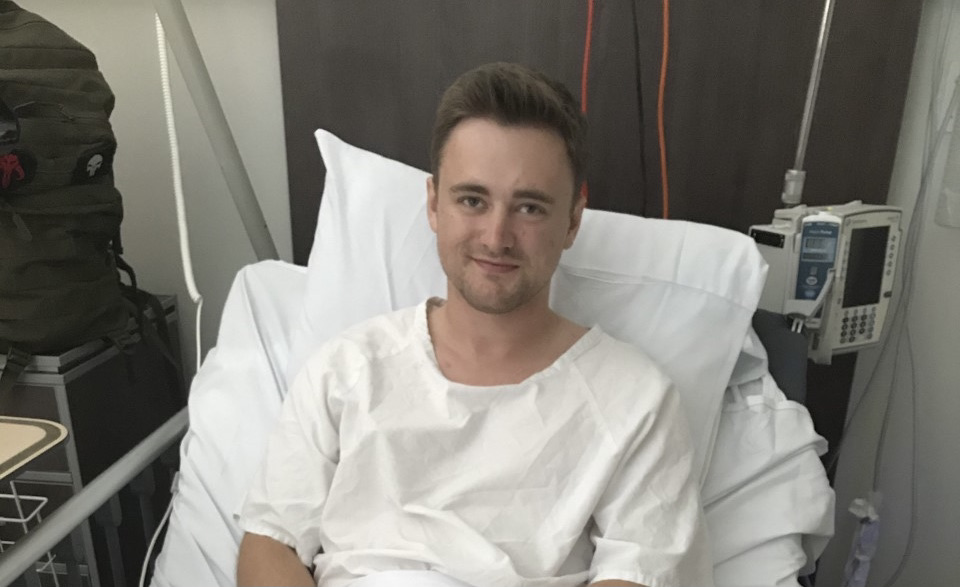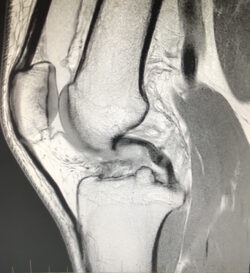
Interview with Justin Shaw: What happens when you injure your ACL
You may recognise SportUNE’s Sports Development Coordinator Justin Shaw from around the gym, or more recently, the author behind our latest sport & training blogs! Justin’s role involves looking for opportunities to provide a wider scope of sporting competitions at SportUNE. He also coached the UNE futsal and touch squads this year whilst helping out with a few other sports. It’s safe to say he is crazy about his sports!
Six months ago Justin tore his ACL ligament which is essential to an athlete’s ability in many sports. This injury can be pretty common for athletes, and also pretty unpleasant with many having to undergo surgery to repair the torn ligament. For many, tearing an ACL ligament means a long and arduous recovery, but Justin was determined to not let the injury keep him away from playing his favourite sports.
We recently caught up with Justin to find out a little bit more about the injury, and what his recovery was like.
Before we dive into the discussion surrounding your ACL injury, can you tell us a little bit about your sporting interests?
I love all sports; I feel like they’re always an opportunity to master a skill. Growing up I played every sport I could, such as soccer tennis, touch, rugby, netball, I even tried AFL a few times and it was nearly the death of me. If you play AFL, congrats on living dangerously. I also enjoyed athletics, especially short-distance sprinting, long jump, high jump, and 4x100m relay, and can’t forget to mention my love for water skiing too!
When I was 15, I injured my hip and that required a few months of bed rest. This is when my physiotherapist put me onto recovery work in the gym, and my introduction to resistance training began.
A little while ago you tore your ACL, how did this injury occur?
I was playing futsal and moved my leg the wrong way. I tried to take a shot, missed completely, landed left foot down while rotating inward, and my momentum carried me to the left. All perfect conditions to rupture the ACL.
What exactly is the ACL ligament?
The ACL is a crucial ligament in the stabilisation of your knee, it is also key in quad extension and the rotation of the lower leg. The ideal situation for an ACL rupture to occur is any movement that involves the knee collapsing inward with internal rotation of the upper thigh, while your lower leg is stationary or rotates outward. My movement pattern that night at futsal ticked every single box on the checklist of how to snap a ligament, like a Christmas cracker.
ACL stands for Anterior (front), Cruciate (meaning ‘cross shaped’), Ligament (meaning ‘bond/ to bind’).
So, when you hear ACL, think front cross-shaped bond. The ACL connects from the back of the femur (the upper leg) through the knee joint itself, and onto the front of the tibia (lower leg). Regarding sport, the ACL is essential for rapid changes in direction, pivoting, running, and jumping. Essentially without an ACL you can walk but not much else. Even walking up or downstairs is an issue without an ACL. As you can imagine this rules out a lot of sports.
What happened after you tore the ACL?
I went to the emergency department immediately. They gave me some pain management and sent me home, and the next day I went and got an X-Ray. My knee wasn’t swollen yet so I had high hopes it wasn’t badly injured. I had done some x-ray reading as part of my degree, so I asked to have a look at the scans rather than wait for a report. The first thing I noticed was a pea-sized chunk of bone floating in the middle of my knee joint – which didn’t look good! The MRI was next. Again, I asked to see the scans, and I saw ruptured spindles of my ACL, like the ends of a frayed rope. I had also pulled my meniscus out of its capsule. My heart didn’t just sink, it snapped like the titanic, and then exploded, twice. I had spent the last few years training toward a personal goal and in an instant, all that work was undone, potentially permanently. That sucked.

Afterward, I made an appointment to see my GP. He gave me the name of a few great surgeons in Sydney. I did some research too and found the one I thought would be best and made an appointment to go down and see him.
It took some time for my operation to take place. Partly because I was still showing signs of swelling and they can’t operate on a knee until all the swelling has subsided, which usually takes around 4 weeks. It ended up being about 8 weeks before I went to Sydney for surgery, no thanks to the peak of the COVID lockdowns delaying it also. In that time, I worked with my fantastic Physiotherapist Nick Grob to restore my quad strength and my knee’s range of motion.
The ACL surgery is usually repaired with a graft made of tendon. After about 6 months, your graft converts from tendon to ligament. This is the danger point for most reconstructions, as the graft is actually at its weakest at this time. The whole recovery process takes 12-24 months depending on a variety of factors, each recovery is different to each individual.
What is your recovery like now?
I’m coming up to 6 months post-operation. I was essentially back to strength training after a month from the surgery to restore my muscle from wastage. 8 weeks ago I got the all clear to begin open chain and heavy strength training which makes it so much easier to work the quad and the hamstring. However, I can’t run or jump just yet. In order to be cleared for straight line running you need to pass a variety of fitness tests which I’m slowly working my way up to. The important thing is not to rush. I understand now why re-injuring is so common because I feel way stronger than I was pre-rupture. I always have to remind myself that I am not.
Who gets these injuries, and is there a particular reason why?
Athletes are always more prone to injury, it’s just the nature of the game (pun intended). But the ACL is a key part of any movement that involves rapid change of direction and/or rapid change in speed. So the multidirectional sports with twisting and stepping can put athletes at particular risk. Soccer is a big leader in ACL injuries, along with rugby union, touch football, netball, rugby league, and basketball. Last I heard, Australia was leading the world in ACL injuries due to sport, and women’s soccer had the highest incidence of ACL injuries per 10,000 players.
Is there any way to avoid this injury?
Learn correct movement techniques for your sport. By far the best way to prevent these injuries is to move properly and efficiently for your body. Another big risk eliminator is strength and conditioning.
What are your top tips for recovering & resting from a sporting injury?
Rest, Ice, Compression, Elevation.
I spent two weeks hooked up to a GameReady device and this essentially eliminated the need for painkillers. Cannot recommend the product enough! Get onto your physio as soon as possible, I was following the Melbourne 2.0 ACL protocol. This is pretty much the gold standard for ACL rehab programs. I got into it as soon as I possibly could and my physio Nick Grob was such an integral part of my recovery process. I wouldn’t have made the progress I have in the time I have had without his help and guidance. Most important of all is DO NOT RUSH. I promise patience is the key to these things. Work through your program, tick boxes as they come, and don’t lose focus.
I’ve helped people recover from ACL injuries before as a trainer but going through it firsthand was an absolute nightmare. I gained so much respect for people who come back from these injuries when it’s so easy to quit.
I need to add that I was very lucky. It sounds funny to say it out loud but it was just an ACL. Many other people I know have had it far worse. Very lucky that I was in a position to surround myself with the best medical and rehab advice. Also very lucky to work at a gym where all your recovery needs are catered to under one roof.
Thank you Justin for providing insight into your ACL injury and recovery, we hope it helps others understand more behind the injury and ways to cope. It’s also great to see you back in the strength and conditioning corner of the gym! If anyone would like to know more about Justin’s recovery or training, you can find his friendly face at SportUNE – he’s always up for a chat!
Discover the positive effects of health and fitness!
We have a team of highly qualified independent, friendly and experienced personal trainers to help you with your health goals. Come in and speak to our friendly team or visit our website for more.


